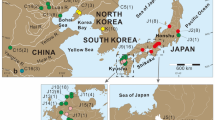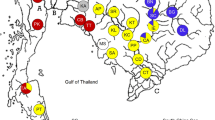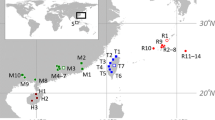Abstract
The swamp eel Monopterus albus is widely distributed in tropical and subtropical freshwaters ranging from Southeast Asia to East Asia, and is unique in its ability to breathe air through the buccal mucosa. To examine the genetic structure of this widespread species, molecular phylogenetic analyses of mitochondrial 16S rRNA sequence (514 bp) were conducted for 84 specimens from 13 localities in Southeast and East Asia. The analyses showed clearly that this species can be genetically delineated into three clades based on geographical populations [China–Japan (Honshu + Kyushu), Ryukyu Islands, and Southeast Asia clades], with each clade exhibiting its own reproductive behavior. Therefore, “M. albus” is believed to be composed of at least three species. The Southeast Asia clade with the highest genetic diversity may include more species. The Ryukyu clade was estimated to have diverged more than 5.7 million years ago, suggesting that the Ryukyuan “M. albus” is native. In contrast, in the China–Japan clade, all haplotypes from Japan were closely related to those from China, suggesting artificial introduction(s).


Similar content being viewed by others
References
Alves-Gomes JA (1999) Systematic biology of gymnotiform and mormyriform electric fishes: phylogenetic relationships, molecular clocks and rates of evolution in the mitochondrial rRNA genes. J Exp Biol 202:1167–1183
Avise JC (2000) Phylogeography. The history and formation of species. Harvard University Press, Cambridge
Bânârescu P (1990) Zoogeography of fresh waters, vol 1: general distribution and dispersal of freshwater animals. AULA-Verlag, Wiesbaden
Bargelloni L, Ritchie PA, Patarnello T, Battaglia B, Lambert DM, Meyer A (1994) Molecular evolution at subzero temperatures: mitochondrial and nuclear phylogenies of fishes from Antarctica (Suborder Notothenioidei), and the evolution of antifreeze glycopeptides. Mol Biol Evol 11:854–863
Chan STH, Phillips JG (1967) The structure of the gonad during natural sex reversal in Monopterus albus (Pisces: Teleostei). J Zool Lond 151:129–141
Clement M, Posada D, Crandall KA (2000) TCS: a computer program to estimate gene genealogies. Mol Ecol 9:1657–1659
Collins TM, Trexler JC, Nico LG, Rawlings TA (2002) Genetic diversity in a morphologically conservative invasive taxon: multiple introductions of swamp eels to the Southeastern United States. Conserv Biol 16:1024–1035
Environmental Agency of Japan (1991) Threatened species of Japan—red data book, vertebrates. Japan Wildlife Research Center, Tokyo
Felsenstein J (1985) Confidence limits on phylogenies: an approach using the bootstrap. Evolution 39:783–791
Huelsenbeck JP, Crandall KA (1997) Phylogeny estimation and hypothesis testing using maximum likelihood. Ann Rev Ecol Syst 28:437–466
Imatani N (1980) Taunagi (swamp eel). In: Kawai T, Kawanabe H, Mizuno N (eds) Nihon no tansui-seibutsu: shinryaku to kakuran no seitaigaku [freshwater organisms in Japan: ecologies of invasions and disturbances]. Tokai University Press, Tokyo, pp 87–92
Kuroiwa H (1927) Catalogue of fresh water fishes collected in Riukiu Curve, 1912–1925. Zool Mag 39:355–368
Liem KF (1963) Sex reversal as a natural process in the synbranchiform fish Monopterus albus. Copeia 1963:303–312
Liu CK (1944) Rudimentary hermaphroditism in the synbranchoid eel, Monopterus javanensis. Sinensia 15:1–8
Liu FG, Hu SH (1980) Egg and larva development of mud eel, Monopterus albus. Bull Taiwan Fish Res Inst 1980:557–562
Löytynoja A, Milinkovitch MC (2003) A hidden Markov model for progressive multiple alignment. Bioinformatics 19:1505–1513
Mabuchi K, Senou H, Suzuki T, Nishida M (2005) Discovery of an ancient lineage of Cyprinus carpio from Lake Biwa, central Japan, based on mtDNA sequence data, with reference to possible multiple origins of koi. J Fish Biol 66:1516–1528
Mabuchi K, Senou H, Nishida M (2007) Mitochondrial DNA analysis reveals cryptic large-scale invasion of non-native genotypes of common carp Cyprinus caprio in Japan. Mol Ecol 17:796–809
Matsumoto S (1997) The swamp eel. In: Japan Fisheries Resource Conservation Association (ed) Basic data about rare Japanese wild aquatic organisms (IV). Japan Fisheries Resource Conservation Association, Tokyo, pp 261–265
Matsumoto S, Iwata K (1997) Paternal egg guarding and mouthbrooding in the bubble nest in the swamp-eel, Monopterus albus. Jpn J Ichthyol 44:35–41
Matsumoto S, Nagai N, Imanishi S, Hasuike H, Kohda M (1998) An expanding distribution of a swamp-eel Monopterus albus. Jpn J Ecol 48:107–116
Matsumoto S, Fujimoto H, Takehara K, Nishida M, Kohda M (2007) Ecology and morph traits of the swamp eel Monopterus albus (Synbranchiformes: Synbranchidae) on the Ryukyu Islands, Japan. Kansai Organ Conserv Nat 29:5–18
Moritz C (1994) Application of mitochondrial DNA analysis in conservation: a critical review. Mol Ecol 1994:401–411
Nakabo T (2002) Synbranchidae. In: Nakabo T (ed) Fishes of Japan with pictorial keys to the species, English edn. Tokai University Press, Tokyo, pp 511, 1506
Posada D, Crandall KA (1998) MODELTEST: testing the model of DNA substitution. Bioinformatics 14:817–818
Rosen DE, Greenwood PH (1976) A forth neotropical species of synbranchid eel and the phylogeny and systematics of synbranchiform fishes. Bull Am Mus Nat Hist 157:1–70
Sanderson MJ (1997) A nonparametric approach to estimating divergence times in the absence of rate constancy. Mol Biol Evol 14:1218–1231
Sanderson MJ (2002) Estimating absolute rates of molecular evolution and divergence times: a penalized likelihood approach. Mol Biol Evol 19:101–109
Swofford DL (2002) PAUP*. Phylogenetic analysis using parsimony (*and other methods), ver 4.10. Sinauer Associates, Sunderland
Takezaki N, Rzhetsky A, Nei M (1995) Phylogenetic test of the molecular clock and linearized trees. Mol Biol Evol 12:823–833
Tamura K, Nei M (1993) Estimation of the number of nucleotide substitutions in the control region of mitochondrial DNA in humans and chimpanzees. Mol Biol Evol 10:512–526
Templeton AR, Crandall KA, Sing CF (1992) A cladistic-analysis of phenotypic associations with haplotypes inferred from restriction endonuclease mapping and DNA-sequence data. 3. Cladogram estimation. Genetics 132:619–633
Thompson JD, Gibson TJ, Plewniak F, Jeanmougin F, Higgins DG (1997) The Clustal X windows interface: flexible strategies for multiple sequence alignment aided by quality analysis tools. Nucleic Acids Res 25:4876–4882
Watanabe K, Takahashi H, Kitamura A, Yokoyama R, Kitagawa T, Takeshima H, Sato S, Yamamoto S, Takehana Y, Mukai T, Ohara K, Iguchi K (2006) Biogeographical history of Japanese freshwater fishes: phylogeographic approaches and perspectives. Jpn J Ichthyol 53:1–38
Yamaguchi M, Miya M, Okiyama M, Nishida M (2000) Molecular phylogeny and larval morphological diversity of the lanternfish genus Hygophum (Teleostei: Myctophidae). Mol Phylogenet Evol 15:103–114
Acknowledgments
We thank H. Fujimoto (Yaeyama Agriculture and Forestry High School), K. Takehara (Okinawa Prefectural Museum), F. Sato (Kumejima Firefly Pavilion), and M. Taira (Ishigaki City Office) for their cooperation with the collection of specimens in the Ryukyu Islands. We are also grateful to B. Ridersius (Murakabi Biana K. K.) for helping with the sampling in Yogyakarta, as well as to C.S. Tzeng (National Tsing Hus University) and T.L. Tao (Taiwanese Freshwater Fish Museum) for their help with sampling in Taiwan. We also thank two anonymous reviewers for their constructive comments aimed at improving the manuscript. This study was supported in part by grants-in-aid for the Encouragement of Scientists awarded to S.M. (17916021) and for Scientific Research to M.N. (15380131, 19207007) by the Japan Society for the Promotion of Science.
Author information
Authors and Affiliations
Corresponding author
About this article
Cite this article
Matsumoto, S., Kon, T., Yamaguchi, M. et al. Cryptic diversification of the swamp eel Monopterus albus in East and Southeast Asia, with special reference to the Ryukyuan populations. Ichthyol Res 57, 71–77 (2010). https://doi.org/10.1007/s10228-009-0125-y
Received:
Revised:
Accepted:
Published:
Issue Date:
DOI: https://doi.org/10.1007/s10228-009-0125-y




